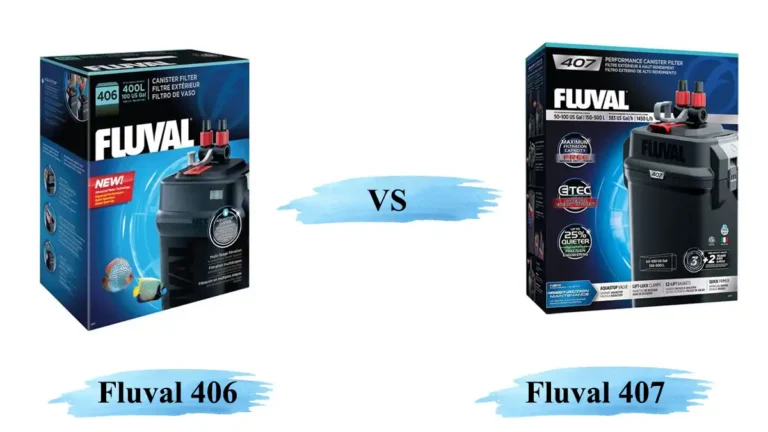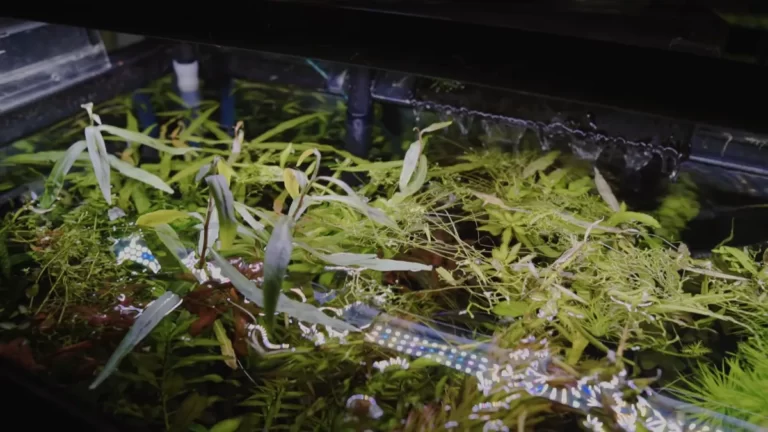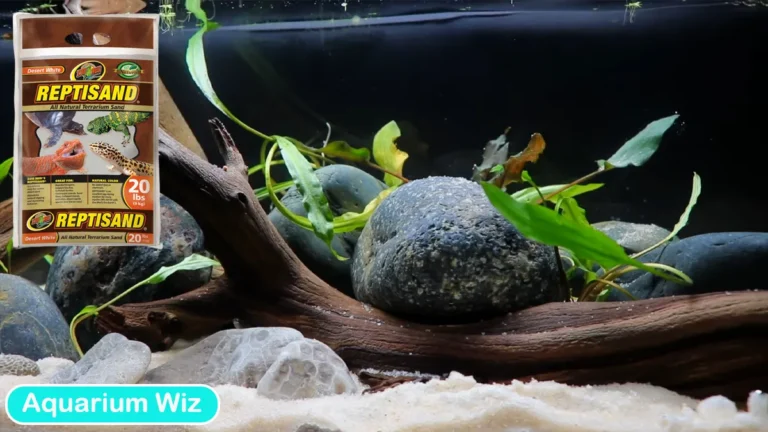What Causes High Alkalinity in Reef Tanks: Understanding the Root Causes
High alkalinity in a reef tank can cause a variety of problems for the tank’s inhabitants. Alkalinity is the measure of the buffering capacity of water and is an important parameter in maintaining a healthy reef tank. Understanding what causes high alkalinity is crucial in managing the levels in the tank.
There are several causes of high alkalinity in a reef tank. One of the most common causes is low calcium levels. Calcium and alkalinity are closely related, and when calcium levels are low, alkalinity levels can rise. Another cause of high alkalinity is over-dosing of alkalinity supplements. It is important to measure alkalinity levels regularly and adjust dosing accordingly to prevent over-dosing.
Key Takeaways
- Low calcium levels can cause high alkalinity in a reef tank.
- Over-dosing alkalinity supplements can also cause high alkalinity.
- High alkalinity can cause damage to equipment and coral tissue in the tank. Regular monitoring and adjustment of alkalinity levels is important in maintaining a healthy reef tank.
High alkalinity can have negative effects on the reef tank’s inhabitants. It can lead to the precipitation of calcium carbonate on equipment and sand, which can cause damage and reduce the efficiency of the equipment. High alkalinity can also cause coral tissue to thin, leading to “alkalinity burn” from the tank lights. Managing alkalinity levels is crucial in maintaining a healthy reef tank.
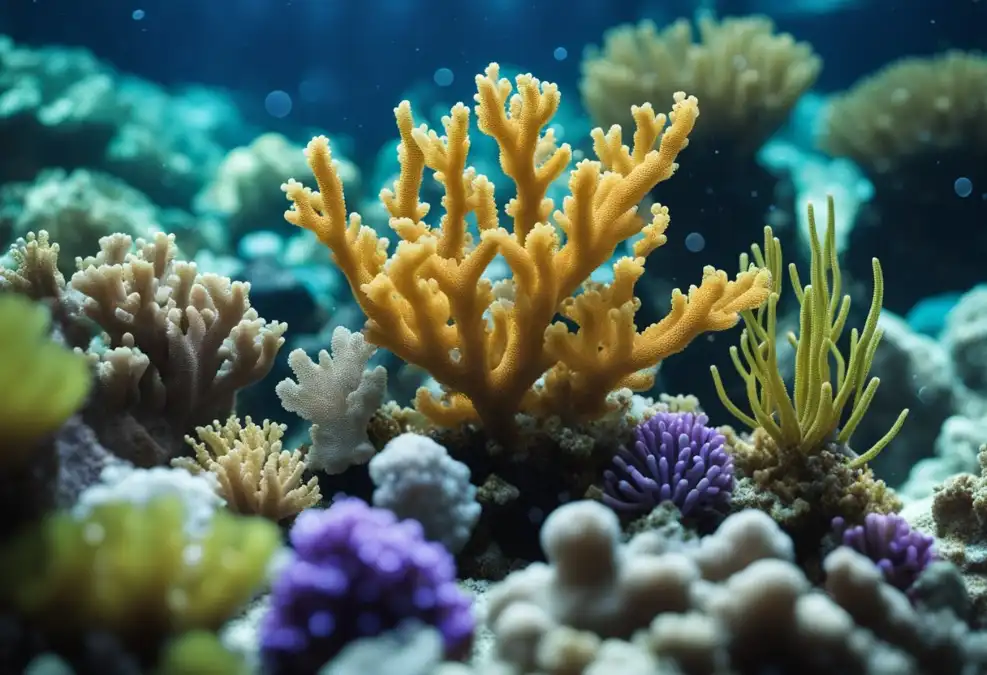
Understanding Alkalinity in a Reef Tank
Maintaining proper alkalinity levels in a reef tank is crucial for the health and growth of coral. Alkalinity refers to the water’s ability to neutralize acids. It is measured in dKH (degrees of carbonate hardness) or ppm (parts per million) and is a critical parameter in reef tank chemistry.
Alkalinity is closely related to pH and is affected by the presence of carbonate, bicarbonate, and carbonic acid in the water. Carbonate and bicarbonate are the primary components of alkalinity, while carbonic acid is a weak acid that forms when carbon dioxide dissolves in water.
Calcium carbonate is a significant component of coral skeletons, and the growth of coral depends on the availability of carbonate ions in the water. When alkalinity levels are too low, the water becomes acidic, and the coral’s ability to grow and calcify is reduced. On the other hand, when alkalinity levels are too high, it can cause precipitation of calcium carbonate on pumps, heaters, and sand, leading to equipment damage.
The ideal alkalinity level for a reef tank is between 7-12 dKH, with 8-10 dKH being the most commonly recommended level. However, different types of coral may have different alkalinity requirements. It is crucial to monitor and maintain stable alkalinity levels to promote coral health and growth.
In summary, understanding alkalinity in a reef tank is essential for maintaining proper water parameters and promoting coral growth. It is a delicate balance, and regular monitoring and adjustments may be necessary to ensure the health and longevity of a reef tank.
Causes of High Alkalinity
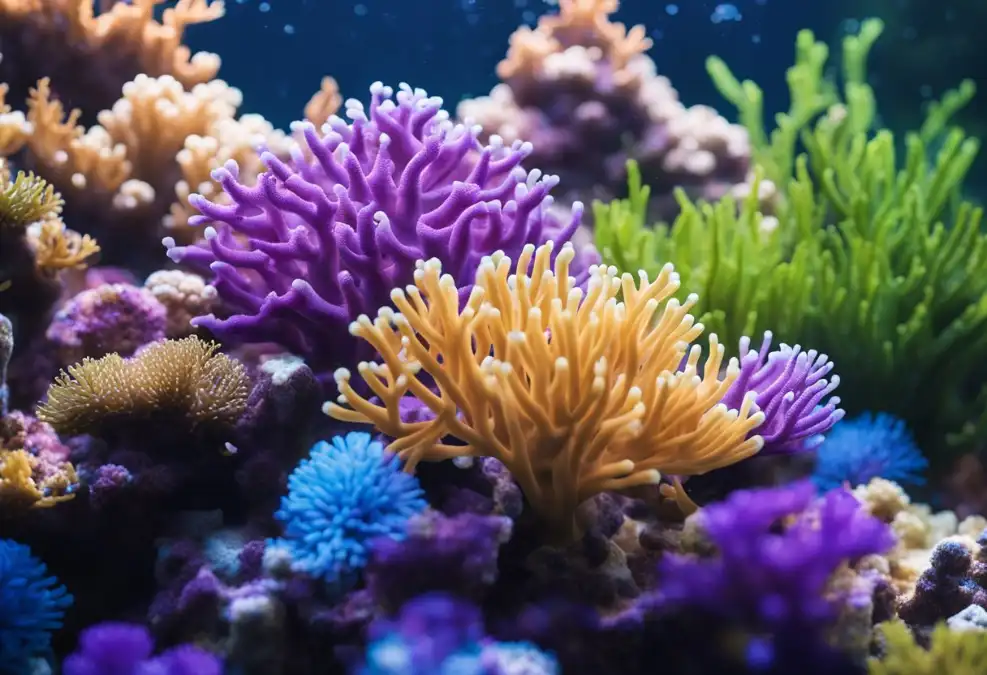
High alkalinity in a reef tank can be caused by various factors. One of the primary causes is the presence of calcium in the water. Calcium is an essential element for the growth of corals and other marine organisms, and it can contribute to the alkalinity of the water. As corals grow, they absorb calcium and carbonate ions from the water, which can cause the alkalinity to rise.
Another factor that can contribute to high alkalinity is the pH level of the water. If the pH level is too high, it can cause the alkalinity to rise as well. This can be caused by a variety of factors, including the use of tap water, evaporation, and temperature fluctuations.
Testing the water regularly is important to ensure that the alkalinity level is within the appropriate range. Water changes and dosing with alkalinity supplements can help to maintain stable alkalinity levels in the tank.
It is important to note that swings in alkalinity levels can be harmful to corals and other marine organisms. High alkalinity levels can cause tissue loss and burnt tips, while lower alkalinity levels can lead to alkalinity burn and pH swings.
To correct high alkalinity levels, there are a few methods that can be used. Adding acids such as white vinegar or soda ash can help to lower alkalinity levels. However, it is important to be cautious when using these methods as they can cause swings in pH and stability. Another option is to use a salt mix with lower alkalinity levels or to perform a water change with low alkalinity water.
Overall, maintaining stable alkalinity levels is crucial for the health and growth of corals and other marine organisms in a reef tank. Regular testing and corrections can help to prevent swings in alkalinity and ensure a healthy environment for marine life.
Effects of High Alkalinity on Reef Tank
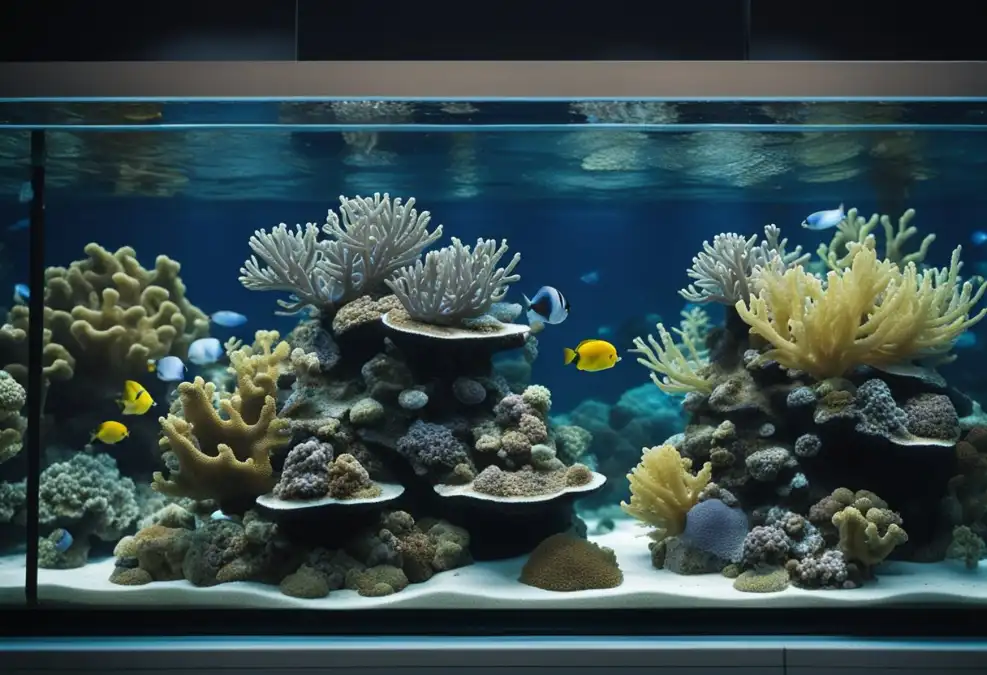
High alkalinity levels in a reef tank can have several negative effects on the organisms living in the tank. One significant effect is on the growth and health of corals. When alkalinity levels are too high, the coral’s tissue and skeleton may become damaged, which can lead to coral bleaching and even death. Randy Holmes-Farley, a chemist who specializes in reef aquariums, recommends keeping alkalinity levels between 7 to 11 meq/L for optimal coral growth and health.
In addition to harming corals, high alkalinity levels can also have negative effects on other organisms in the reef tank. Fish and invertebrates, for example, may experience alkalinity burns, which can cause damage to their mucus layer and lead to infections. High alkalinity levels can also cause coralline algae to stop growing and can lead to an increase in phosphate and nitrate levels, which can harm the organisms in the tank.
It is important to note that while low alkalinity levels can also be harmful to the reef tank, maintaining the ideal alkalinity range is crucial for the health of the organisms living in the tank. Hard corals, for example, require a stable alkalinity level to maintain their calcium hardness and grow properly. SPS corals, which are small polyp stony corals, are especially sensitive to changes in alkalinity levels and may not survive if the levels are too high or too low.
To maintain the ideal alkalinity level in a reef tank, it is essential to test the alkalinity regularly and adjust it as needed. The demand for alkalinity will vary depending on the tank’s inhabitants and the nutrients present in the saltwater aquarium. By keeping the alkalinity level within the recommended range, the organisms in the reef tank can thrive and grow healthy.
Managing Alkalinity Levels
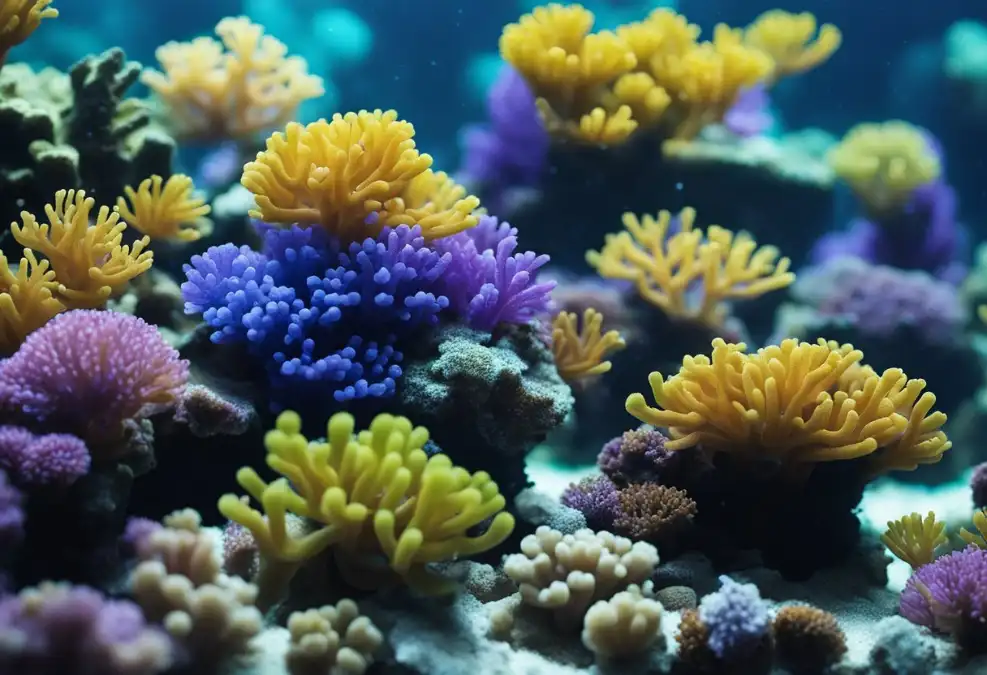
Maintaining proper alkalinity levels is crucial for a healthy reef tank environment. Regular testing with reliable test kits is necessary to keep track of the alkalinity levels. If the alkalinity levels are too high, it can cause coral skeletons to melt and affect the flesh on top. On the other hand, low alkalinity can lead to poor coral growth and health.
To manage alkalinity levels, there are several methods that can be used. One way is to add calcium carbonate supplements to the tank. This can help raise alkalinity levels and maintain the carbonate hardness needed for healthy coral growth. Dosing pumps can be used to add the supplements to the tank gradually.
Another way to manage alkalinity levels is through water changes. Daily 20-25% water changes can slowly reduce alkalinity levels and help reach the desired level. It is important to use reverse osmosis water since it is free of almost all minerals with very low total dissolved solids (TDS) and hardness. The fresh water should be mixed with a high-quality salt mix that has a DKH of 8 or less.
In some cases, vinegar or baking soda can be used to lower alkalinity levels. However, it is important to use caution when using these methods as they can affect the pH levels in the tank. Limewater or kalkwasser can also be used to raise alkalinity levels. These methods involve adding calcium hydroxide to the tank and require the use of pumps and heaters to maintain the proper levels.
It is important to note that high nitrates, ammonia, and salinity levels can also affect alkalinity levels. Therefore, it is important to keep these levels in check as well. Test strips can be used to monitor these levels regularly.

Frequently Asked Questions
How can I raise the alkalinity in my reef tank?
To raise the alkalinity in a reef tank, you can add alkalinity supplements such as baking soda, calcium hydroxide, or a commercial alkalinity product. It’s important to test the water regularly and add supplements as needed to maintain stable alkalinity levels. However, it’s also important to avoid sudden changes in alkalinity levels, as this can stress and harm the corals and other marine life in the tank.
What are some causes of low alkalinity in a reef tank?
Low alkalinity in a reef tank can be caused by a variety of factors, including inadequate buffering capacity, excessive carbon dioxide, and excessive organic matter. Inadequate buffering capacity can be caused by using low-quality salt mix or failing to perform regular water changes. Excessive carbon dioxide can be caused by poor ventilation or high levels of respiration in the tank. Excessive organic matter can be caused by overfeeding, poor filtration, or inadequate water circulation.
What is a high dKH level in a reef tank?
dKH is a unit of measurement for alkalinity in a reef tank. A high dKH level in a reef tank can be harmful to corals and other marine life, as it can cause the pH to become too high and lead to “burning” of the corals. The optimal range for dKH in a reef tank is typically between 8-12 dKH. If the dKH level is too high, it can be lowered by performing a partial water change or adding an acid buffer. However, it’s important to make any adjustments slowly to avoid stressing the corals and other marine life in the tank.

